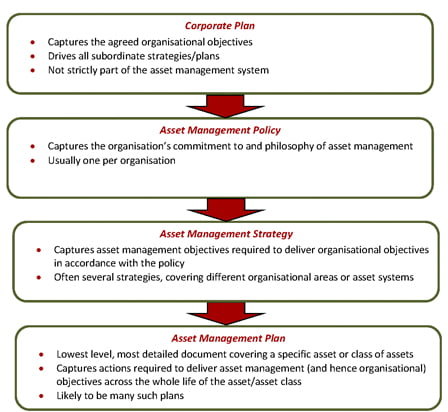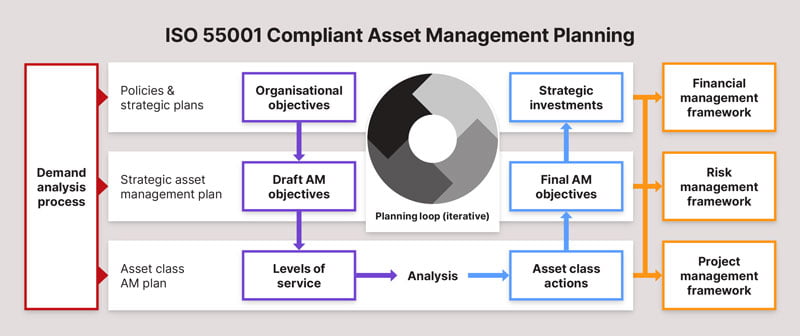What is an asset management plan?
This article looks at arguably the most important documents in any asset management system – the plans that capture the actions to be taken on each asset.
An asset management plan is one of the core documents in an asset management system. ISO 55001 establishes the following generic hierarchy for such documents:

Note that names of the documents are not important – many organisations call asset management plans “whole of life plans” or “asset plans” and this does not affect their asset management performance. Content is far more important and should include the following:
- Asset description – information clearly establishing which assets fall within the scope of the Asset Management plan, what these assets do and how this is important
- Objectives/Levels of service – the performance/cost/risk objectives the for assets within the scope of the plan. These objectives must align with higher level objectives contained in the Strategic Asset Management plan and organisational plan.
- Current and forecast levels of performance – the current level of performance against each of the objectives listed in the previous section (noting any gaps or issues)
- Risks – an analysis of the risks to achievement of objectives over the long term (largely arising from the identified gaps and issues)
- Actions – planned actions to close the gaps between forecast and desired levels of performance and to control risks. Include the timeframes and resources required to execute those actions
- Budget – a comparison of the allocated and required resources (again, highlighting any gaps)
The value in this type of document comes from the mere fact of writing it as well as subsequent use. Preparation allows the Asset Manager to identify any uncertainty around the expectations for the asset (for example, it is common for the expected life of an asset and the triggers for retirement to be poorly defined). Once prepared, the document becomes the single point of truth for its contents and can be used to communicate this across the organisation. For example, the plan will show the accountants the on-going budget needs (both Operating Expenditure and Capital Expenditure), show Project Managers the likely timing of upcoming projects and show managers of interfacing assets when they can expect a change in the interface. Perhaps most critically, it shows senior executives the level of risk inherent in the asset and the robustness of the associated controls.
Development of an asset management plan
It can be seen from the above that the process for generating asset management plans must deliver line of sight (one of the pillars of asset management as discussed in our “What is Asset Management?” article) from the agreed organisational objectives to the specific objectives/levels of service required from a particular asset or asset class. Further, if the plan is to be achievable and optimised at the organisational level, there must be an iterative process of refining the objectives and the actions. A suitable planning process is illustrated in the following diagram:

Tips and Tricks
Structure
Many physical assets are complicated things and there is often a sense that the plans for managing them should also be complex – and long! There is clearly a need to capture the technical details of an asset, but the plan is not the place. Remember that the audience includes non-technical parts of the organisation and follow these rules:
- Keep it short
- Make it visual
- Reference the details for those who want them
The first time
There is a real “chicken and egg” problem with getting into asset management planning – how can you write a plan without objectives from the Strategic Asset Management Plan and how can you write a Strategic Asset Management Plan without plans to tell you what’s possible? There is no perfect answer, so just pick a point in the process that works for you. Asset management is a continuous improvement process, so you’ll have a chance to fix whatever you get wrong in the next round!
A living document
Don’t forget to keep your asset management plans “alive” – they do no good (and may even do harm) if they are left on the shelf and become out of date. In addition to regular review (we suggest that this should occur in line with your organisation’s annual business planning process), the plans should be updated whenever a significant event occurs affecting the content.
Good luck and happy planning!
If you enjoyed this article and want to receive notifications of future articles that we publish, please sign up for our newsletter here.
